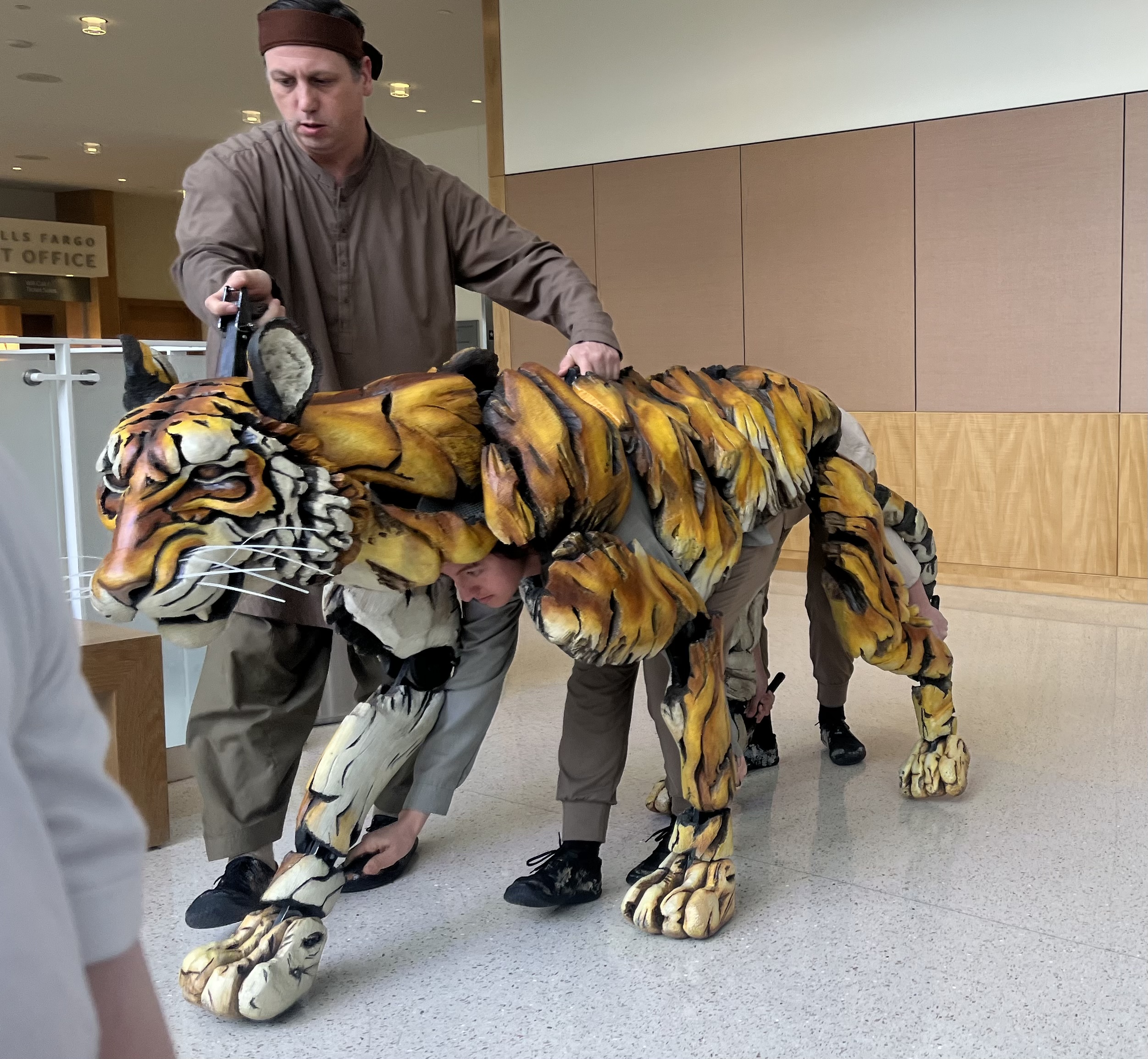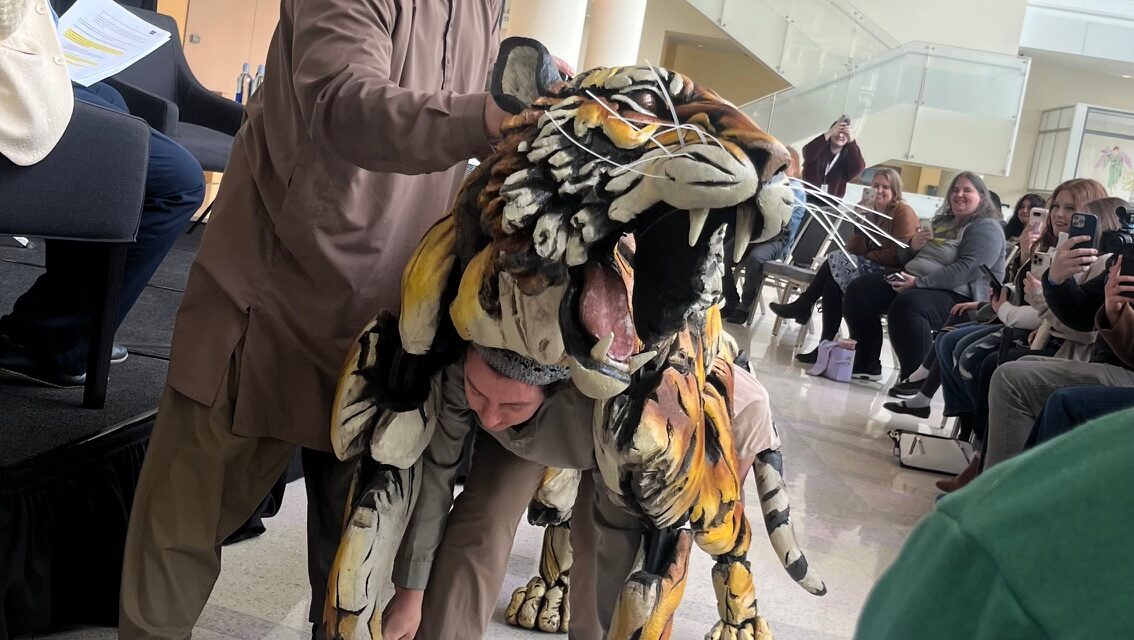SALT LAKE CITY — Life of Pi is a thrilling story about a boy named Piscine “Pi” Patel who ends up trapped on a lifeboat with a hyena, a zebra, an orangutan, and a Bengal tiger named Richard Parker. We had the exciting opportunity to get an up-close look at the puppet of Richard Parker, as well as listen to a talk-back with some of the technical staff and some of the actors/puppeteers.
In Life of Pi, the puppet of Richard Parker is operated by three puppeteers working together in harmony. Each puppeteer controls a specific part of Richard and is referred to by their role. For instance, the Head puppeteer controls the head, mouth, and ears. The Heart puppeteer holds the puppet along their back and moves the front paws. The Hind puppeteer maneuvers the tail and hind legs of the puppet.
Furthermore, US Assistant Puppetry Director, Betsy Rosen explained that each puppeteer plays an emotional role in addition to their practical role. Puppeteers Aaron Haskell, Anna Vomáĉka, and Anna Leigh Gortner elaborated about what their role means artistically. Aaron Haskell is the Head puppeteer and acts as the eyes of the tiger and reacts to the world of the stage. Anna Vomáĉka, the Heart puppeteer, takes the reactions from the Head puppeteer and changes Richard’s breathing. Finally, Anna Leigh Gortner, the Hind puppeteer, maneuvers the tail to express Richard Parker’s emotions and thoughts. His tail wags like a dog if Richard is excited, or still when Richard is alert. Besty Rosen also introduced the concept of the fourth puppeteer: the actor/puppets on stage that help to convince the audience Richard is a real animal.
Interestingly, Richard Parker is not performed by the same group every night. There are eight puppeteers in total, creating up to twelve different Richard Parker combinations, each with its own nuances. Initially, the puppeteers worked in fixed trios to build synchronization. Over time, they began mixing up the combinations, starting with the Hind puppeteers and eventually blending the groups entirely. This variety adds to the puppet’s complexity and to the thrill of seeing him come to life on stage.
Taha Mandviwala, actor of Pi, explained how complex the character of Pi truly is and how he portrayed such a complex character. Taha described Pi as not academically smart but wise beyond his years. He then explained how acting with a unique acting partner posed different challenges. The process of acting with a puppet requires two types of “brain”, his technical brain, where he is acting alongside with a puppeteer and needs to understand how the puppet and the puppeteer behave and his emotional brain, where he is with a genuine tiger and needs to show that hesitation while interacting with Richard Parker.

Photos: Leia Alitagtag and Casey Arnold
With such an emotionally challenging role, Taha explained how he practiced emotional hygiene. He needed to understand how it feels to lose someone. How one holds their body, how they breathe, little things that wouldn’t originally come to one’s mind when thinking about how to portray a character. He described that he needed to maintain boundaries with this show so he wouldn’t hurt himself while playing Pi and so he could properly decompress after. Taha also mentioned how at some points, his tears are genuine because of how powerful the story is. He stated that each night, the story is the same but the feeling is different, and how each time he performs, it feels like it is all happening for the first time.
Taha talked about how he has changed as a person since he started acting in this show. This show talks a lot about faith and the struggle with keeping it in dire situations. It made Taha rethink his life and what it means to be human. Taha explained that he grew up in London, Kentucky and how he grew up Muslim but because of where he was raised, he was able to learn all about all kinds of religions and how they celebrated all of them. This helped him portray Pi and better understand humanity and all of the nuances that come with being human.
Seeing the Richard Parker puppet up close was nothing short of mesmerizing. Every subtle twitch of the tail, shift of the paws, and flick of the ears breathed life into the tiger in a way that was both powerful and deeply moving. The artistry and emotional depth poured into each performance of Life of Pi make it a must-see theatrical experience. If you’re curious about how these incredible puppets were brought to life, there’s a behind-the-scenes video showcasing the puppet creation process that’s definitely worth watching. And if you want to witness this magic for yourself, Life of Pi is playing at the Eccles Theatre until April 6th.
Broadway at the Eccles’ production of Life of Pi plays April 1-6 at the George S. and Dolores Doré Eccles Theater, 131 Main St, Salt Lake City. For more information, visit https://saltlakecity.broadway.com/

These reviews are made possible by a grant from the Salt Lake County Zoo, Arts, and Parks program.





